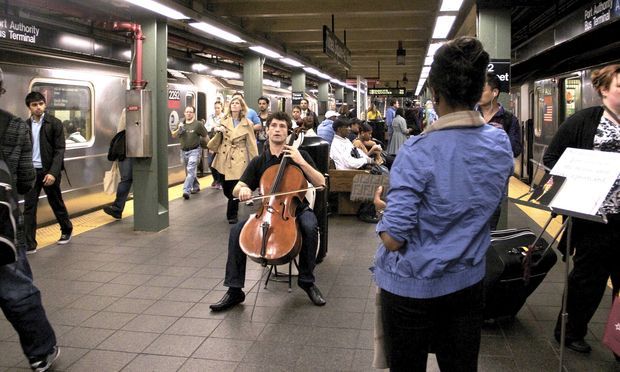In 2010, New York-based cellist Dale Henderson began playing the cello suites of Johan Sebastian Bach in subway stations around the city. His aim was to bring classical music to sections of the public who would normally never have the opportunity to hear it. This year, to coincide with the 330th anniversary of Bach’s birth, events will take place in over 120 cities in 39 countries as part of Bach in the Subways.

Henderson’s hope was that the widespread reports of declining audiences at concerts could be countered by performances in various public places that encouraged enthusiasm for the music. From the beginning, he refused to take money from passers-by as often happens with public performers, focusing instead on the music. Here he explains what he wants to achieve.
Classical music is everything that pop music claims to be — it’s sexy, it’s exciting, it’s fun,” he said in a recent interview. “But for several reasons — marketing, the creation of the recording industry — people don’t get exposed to it much or they assume it’s boring or it’s an old-white-guy thing. By bringing live classical music for free, we aim to change that.”
Any number of great composers could have been chosen to fulfil the role, but Henderson felt Bach was the most appropriate due to the broad reach of his musical works, which even influence performers today in various genres. Traces of his music can be heard in everything from the trumpeting solo on the Beatles Penny Lane, to Paul Simon, Xzibit and Jethro Tull. Paul Elie, an author who has written on Bach’s influence, explains here how Bach’s impact actually went beyond one Beatles recording, and you’ll also get to hear a few samples.
Henderson’s idea struck a chord. The first annual event on 21 March was organised by Henderson and two other musicians in 2011. Now there is a list of hundreds of musicians who have played their part in the celebration. The international movement they have all helped build has established some key principles everyone should stick to, writing on their website, “There are three core elements to a Bach in the Subways day performance: 1) Play J.S. Bach any time from 12am to 11:59pm on Saturday, 21 March 2015. 2) Make sure your performance is open and accessible to all. 3) Decline donations and instead offer your music as a gift.”
Henderson will get things going in New York with a cello performance starting at midnight. The day’s events includes performances in Time Square and at Grand Central station. Meanwhile, on the other side of the world, musicians in Dunedin, New Zealand, will play Bach at various locations throughout the city, reflecting the fact that the event has expanded beyond the subway. In Japan, musicians will kick off a day of Bach’s music in Koyasan, a 1,200-year-old Buddhist town.
In Tokyo, a Bach relay will begin that will also involve a performance by the Dresden philharmonic orchestra in the city’s newly restored Frauenkirche, which was the site of a famous Bach organ recital in 1733 and was destroyed during World War II. The performances will be streamed online. In Lviv, Ukraine, they are planning a Bach marathon, with over 24 hours of continuous performances at three separate venues.
Bach in the Subways will also feature as part of the annual festivities in Leipzig, Germany, where Bach’s birthday has been marked for many years with a series of concerts, events at the Bach museum and a church service. Bach spent close to three decades in the city from 1723 until his death in 1750 as music director of the city’s four main churches.
As well as spreading globally, the movement has grown from Henderson’s cello to embrace a broad range of musical instruments and vocals.
